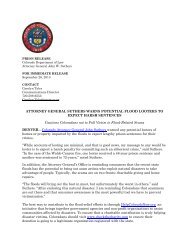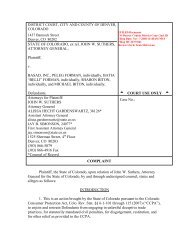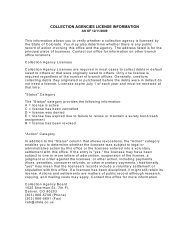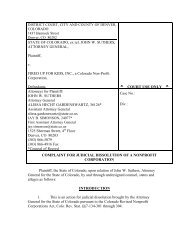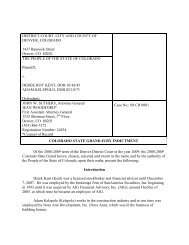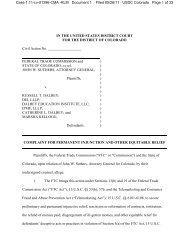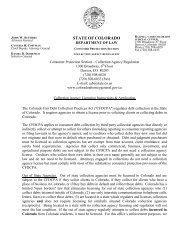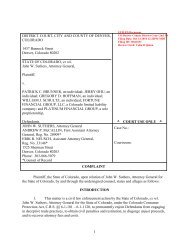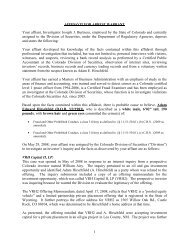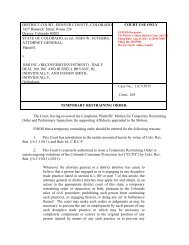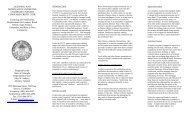brief in opposition to motion to dismiss - Colorado Attorney General
brief in opposition to motion to dismiss - Colorado Attorney General
brief in opposition to motion to dismiss - Colorado Attorney General
You also want an ePaper? Increase the reach of your titles
YUMPU automatically turns print PDFs into web optimized ePapers that Google loves.
Defendants cite the Blue Book for the obvious proposition that by the addition ofAmendment 23, “the state constitution sets a m<strong>in</strong>imum <strong>in</strong>crease <strong>in</strong> fund<strong>in</strong>g.” Like theamendment itself, the Blue Book makes no reference <strong>to</strong> the Education Clause or <strong>to</strong> the fund<strong>in</strong>gof a thorough and uniform system of public education, and certa<strong>in</strong>ly does not <strong>in</strong>clude <strong>in</strong> thestatement of purposes one such as: “the proposed amendment will establish the required fund<strong>in</strong>glevel under article IX, section 2 of the constitution.”Defendants attempt <strong>to</strong> manufacture a conflict between the two constitutional provisionsand resolve it by amend<strong>in</strong>g or <strong>in</strong> effect repeal<strong>in</strong>g the Education Clause. “A conflict exists whenone provision authorizes what the other forbids or forbids what the other authorizes.” Bickel v.City of Boulder, 885 P.2d 215, 228-29 (1994). If their construction is accepted, Amendment 23implicitly amends the Education Clause by fix<strong>in</strong>g an annual dollar standard of compliance withits mandate. For Defendants, the Education Clause now reads: “the general assembly shall . . .provide for the establishment and ma<strong>in</strong>tenance of a thorough and uniform system of free publicschools throughout the state, provided that the costs of fund<strong>in</strong>g such system need not exceed theamount determ<strong>in</strong>ed by the formula set forth <strong>in</strong> article IX, section 17.” Such violence <strong>to</strong> theFramers’ mandate is contrary <strong>to</strong> the rules of construction:“Amendments by implication are not favored,” and we will not presume that the <strong>General</strong>Assembly <strong>in</strong>tended <strong>to</strong> change preexist<strong>in</strong>g law absent a clear expression or a manifest<strong>in</strong>consistency render<strong>in</strong>g harmonization unworkable.In re Marriage of Chalat, 112 P.3d 47, 55 (Colo. 2005) (citations omitted). Further:Repeals by implication are not favored. When two apparently contradic<strong>to</strong>ry statutesrelate <strong>to</strong> the same subject matter and two alternative constructions are possible, one ofwhich will result <strong>in</strong> giv<strong>in</strong>g effect <strong>to</strong> both statutes, while the other will <strong>in</strong>validate onestatute, we will adopt the <strong>in</strong>terpretation that gives effect <strong>to</strong> both statutes rather than theone which results <strong>in</strong> repeal of the earlier statute by implication. Here, the two sentenc<strong>in</strong>gprovisions are not <strong>in</strong> irreconcilable conflict. Rather they can sensibly be read <strong>to</strong>gether <strong>to</strong>give effect <strong>to</strong> both provisions.12



